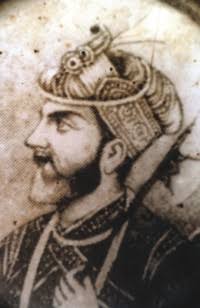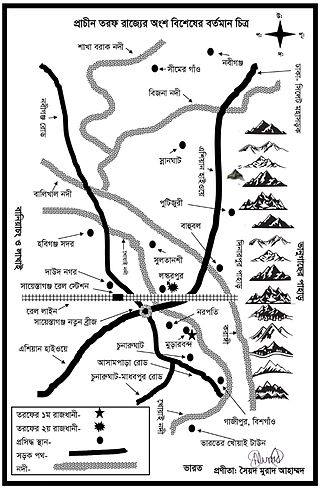Related Research Articles

Isa Khan was the Bais Rajput leader of the 16th-century Baro-Bhuiyan chieftains of Bengal and a zamindar of Khizrpur. During his reign, he successfully unified the chieftains of Bengal and resisted the Mughal invasion of Bengal. It was only after his death that the region fell totally under Mughal control. He remains an iconic figure throughout West Bengal and Bangladesh as a symbol of his rebellious spirit and unity.
Rajmala is a chronicle of the Kings of Tripura, written in Bengali verse in the 15th century under Dharma Manikya I.
The Twipra Kingdom was one of the largest ancient - historical kingdoms of the Tripuri people in Northeast India.

The Greater Sylhet region predominantly included the Sylhet Division in Bangladesh, and Karimganj district in Assam, India. The history of the Sylhet region begins with the existence of expanded commercial centres in the area that is now Sylhet City. Historically known as Srihatta and Shilhatta, it was ruled by the Buddhist and Hindu kingdoms of Harikela and Kamarupa before passing to the control of the Sena and Deva dynasties in the early medieval period. After the fall of these two Hindu principalities, the region became home to many more independent petty kingdoms such as Jaintia, Gour, Laur, and later Taraf, Pratapgarh, Jagannathpur, Chandrapur and Ita. After the Conquest of Sylhet in the 14th century, the region was absorbed into Shamsuddin Firoz Shah's independent principality based in Lakhnauti, Western Bengal. It was then successively ruled by the Muslim sultanates of Delhi and the Bengal Sultanate before collapsing into Muslim petty kingdoms, mostly ruled by Afghan chieftains, after the fall of the Karrani dynasty in 1576. Described as Bengal's Wild East, the Mughals struggled in defeating the chieftains of Sylhet. After the defeat of Khwaja Usman, their most formidable opponent, the area finally came under Mughal rule in 1612. Sylhet emerged as the Mughals' most significant imperial outpost in the east and its importance remained as such throughout the seventeenth century. After the Mughals, the British Empire ruled the region for over 180 years until the independence of Pakistan and India. There was a complete list of the different amils who governed Sylhet which was recorded in the office of the Qanungoh of Sylhet. However, most complete copies have been lost or destroyed. Dates from letters and seal traces show evidence that the amils were constantly changed. In 1947, when a referendum was held, Sylhet decided to join the Pakistani province of East Bengal. However, when the Radcliffe Line was drawn up, Karimganj district of Barak Valley was given to India by the commission after being pleaded by Abdul Matlib Mazumdar's delegation. Throughout the History of Sylhet, raids and invasions were also common from neighbouring kingdoms as well as tribes such as the Khasis and Kukis.
Maha Manikya, also known as Chhengthung Fa, was the Maharaja of Tripura from about 1400 to 1431. Contrary to narratives provided by early histories, evidence indicates that Maha Manikya was the founder of the kingdom, having established dominance over neighbouring tribes in the early 15th century. He is further thought to be the first holder of the title "Manikya", taken in recognition of a historic victory over the neighbouring Bengal Sultanate. The dynasty which he founded continued using the title until Tripura's merger with India in 1949.
Yashodhar Manikya, also known as Jashodhar Manikya, was the Maharaja of Tripura from 1600 to 1618. His reign is considered to be the nadir of the kingdom's history, with the temporary overthrowing of the monarchy and the region's incorporation into the Mughal Empire.

Vijaya Manikya II, also spelt Vijay or Bijoy, was the Maharaja of Tripura from 1532 to 1563. Succeeding to the throne at a young age, Vijaya proved himself to be a formidable military leader, initiating a series of conquests into several surrounding kingdoms, including the powerful Bengal Sultanate. During Vijaya's reign, the might and influence of Tripura reached its zenith, leading to him being viewed as one of its greatest monarchs.
Narendra Manikya was the Maharaja of Tripura from 1693 to 1695.
Ratna Manikya II was the Maharaja of Tripura from 1685 to 1693 and again from 1695 to 1712.

Rajdhar Manikya I, also spelt Rajadhara Manikya, was the Maharaja of Tripura from 1586 to 1600. Formerly a warrior-prince who fought with distinction during his father's reign, upon his own ascension to the throne, Rajdhar showed little interest in such matters, instead becoming occupied with religious pursuits. The decline of Tripura is thought to have begun during his reign.
Ananta Manikya was the Maharaja of Tripura from 1563 to 1567. A weak monarch in comparison to his predecessor, he spent his reign under the control of his influential father-in-law. He died after only a few short years of rule, potentially at the latter's hands.

The Kingdom of Gour was one of the greater of the many petty kingdoms of the medieval Sylhet region. According to legend, it was founded by Gurak, off-shooting from Kamarupa's Jaintia Kingdom in 630. Much of its early history is considered legendary or mythological up until Navagirvana who is mentioned in the Bhatera copper-plate inscriptions. The Kings of Gour are described as patrons of Hindu revivalism in what was previously a predominantly Buddhist and animist populated land.
Udai Manikya I, also known as Gopi Prasad, was the Maharaja of Tripura from 1567 to 1572. Though from a lowly background, he later rose to become one of the most powerful figures in the kingdom. Following the death of the previous monarch, his son-in-law, Udai took royal power himself, for a time supplanting the ruling dynasty with his own line.
Joy Manikya I was the Maharaja of Tripura from 1573 to 1577.

Taraf, previously known as Tungachal, was a feudal territory of the Sylhet region in Bengal and was under many petty kingdoms in different periods of time. It was part of what is present-day Habiganj District in Bangladesh.
Joy Manikya II was the Maharaja of Tripura during the mid-18th-century. He originally gained the throne through popular approval for his military hostility to the Mughal Empire. However, Joy spent much of his reign warring against various relations to maintain his grip on it, in particular with his cousin Indra Manikya II.
Indra Manikya II was the Maharaja of Tripura during the mid-18th-century. His reign was spent struggling for control of the kingdom with his relative Joy Manikya II.
Udai Manikya II was the Maharaja of Tripura briefly during the mid-18th-century, having laid claim to the throne during a power struggle between his relatives Joy Manikya II and Indra Manikya II.

The Greater Noakhali region predominantly includes the districts of Noakhali, Feni and Lakshmipur in Bangladesh, though it has historically also included Bhola, Sandwip and some southern parts of Tripura in India and southern Comilla. The history of the Noakhali region begins with the existence of civilisation in the villages of Shilua and Bhulua. Bhulua became a focal point during the Buddhist and Hindu kingdoms of Pundra, Harikela and Samatata leading it to become the initial name of the region as a whole. The medieval Kingdom of Bhulua enjoyed autonomy under the Twipra Kingdom and Bengal Sultanate before being conquered by the Mughal Empire. At the beginning of the 17th century, Portuguese pirates led by Sebastian Gonzales took control of the ara but were later defeated by Governor Shaista Khan. Affected by floodwaters, the capital of the region was swiftly moved to a new place known as Noakhali, from which the region presently takes its name. By 1756, the British East India Company had dominated and started to establish several factories in the region. The headquarters was once again moved in 1951, to Maijdee, as a result of Noakhali town vanishing due to fluvial erosion.

The Kingdom of Bhulua was a kingdom and later a zamindari covering the present-day Noakhali region of Bangladesh. Its establishment is generally credited to Bishwambhar Sur, a Hindu Rajput of Mithila who passed by the area during a pilgrimage. The kingdom fell under Tripura vassalage in the 15th century, and was reduced to a zamindari (fiefdom) after losing to the Mughals. Most of the kingdom's land has been eroded by the Meghna River.
References
- 1 2 Sarma (1987 , p. 77)
- ↑ Long (1850 , pp. 547–48)
- ↑ Roychoudhury, Nalini Ranjan (1983). Tripura through the ages: a short history of Tripura from the earliest times to 1947 A.D. Sterling. p. 22.
- ↑ Saigal, Omesh (1978). "Rulers of Tripura". Tripura, Its History and Culture. p. 35.
- ↑ Bhattacharya, Apura Chandra (1930). Progressive Tripura. p. 23.
- ↑ Roychoudhury, Nalini Ranjan (1983). Tripura through the ages: a short history of Tripura from the earliest times to 1947 A.D. p. 22.
- ↑ Sarma, Ramani Mohan (1987). Political History of Tripura. Puthipatra. pp. 77–78. OCLC 246861481.
- ↑ Fazlur Rahman. Sileter Mati, Sileter Manush (in Bengali). MA Sattar. p. 49.
- ↑ Bhattasali, NK (1929). "Bengal Chiefs' Struggle for Independence in the Reign of Akbar and Jahangir". Bengal: Past and Present: Journal of the Calcutta Historical Society. 38: 41.
- ↑ Khan (1999), p. 23.
- ↑ Sarma (1987), p. 81.
- ↑ Sarma (1987), pp. 82–84.
- ↑ Long (1850), p. 550.